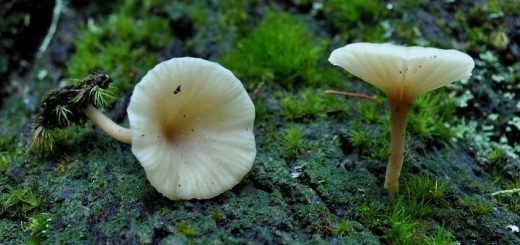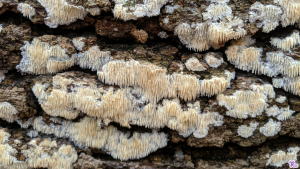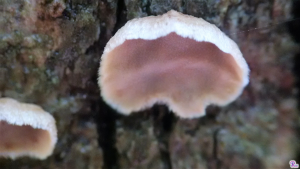#081: Phellinus robiniae, the Cracked Cap Polypore [Archived]
Note: This is an archived post. You can read the current version here.
This woody shelf fungus is found on locust trees. Because of this, identification of this fungus is greatly simplified if you know your trees.
Phellinus robiniae is just one of a number of woody, brown polypores that can be found growing on living or recently deceased trees. As its common name suggests, one of the defining features of the Cracked Cap Polypore is its cap, which becomes deeply cracked in age. When young, this polypore’s cap is light brown and may be velvety. The mushroom is perennial, so a new pore surface is added to the bottom of the mushroom every year. From the top, the new growth appears along the edges of the cap as a light brown, possibly velvety ring. The older layers at the center of the cap stop growing and become dark brown or black and highly cracked with age. At first the mushroom forms a flattish bracket, but this becomes more hoof-shaped as further layers are added to the bottom. The Cracked Cap Polypore can get fairly big: up to 40cm in diameter and 20cm thick.
From below, the mushroom appears fairly uniform. The brown pore surface is composed of tiny pores (7-8 per millimeter), so it looks completely smooth from a distance. However, as a result of the pores, the surface can appear to change between light and dark shades of brown based on viewing angle. P. robiniae has a brown spore print, so don’t be surprised to see a brown smudge running down the tree below the mushroom.
The Cracked Cap Polypore infects living and dead wood of Robinia trees, so it is a parasitic and saprobic species. Infected trees are usually either Black Locust (Robinia pseudoacacia) or New Mexican Locust (Robinia neomexicana). It is only occasionally found on other trees. P. robiniae can be found wherever its host trees are present.
All of the Cracked Cap Polypores that I have found have been too high up in their host trees for me to examine them closely. In these situations, the ability to identify tree species can be an invaluable tool to the mycologist. If you ever find a brown, woody polypore on a locust tree, you can bet it’s the Cracked Cap Polypore. So how do you identify a locust tree? Depending on the time of year, there are four things you can examine: leaves, flowers, seeds, and bark.
The leaves are probably the most helpful feature. Locust leaves are pinnately compound, meaning they have 7-19 leaflets that share a common, non-woody stem. The leaflets themselves are 1-2 inches long, oval, have smooth edges, and are arranged in pairs, with one leaflet directly opposite another. There is also one unpaired leaflet at the end of the leaf, which makes the total number of leaflets odd. Along the supporting branches, the compound leaves are arranged alternately. Locust branches also sport thorns, usually near the base of the leaves.
In the spring, locust trees are easily recognizable by their showy clusters of white or pink flowers. If you take a closer look at the flowers, you will easily recognize that these trees are part of the bean family. Indeed, after the flower is pollinated, it will grow bean-like seed pods. These seed pods remain attached to the tree throughout winter and slowly disperse their seeds.
If you have found this tree in late winter when none of the preceding characteristics are available, you can still look at the bark. Identifying trees based on bark is very difficult, but locust bark is fairly distinctive. The bark is light gray and deeply furrowed in Black Locust but only shallowly furrowed in New Mexican locust. There are a number of trees with furrowed bark, so if you are unsure of what locust bark looks like, then look for the distinctive thorns on the smaller branches.
Locust trees are intolerant of shade, so they are most commonly found around the edges of clearings, where they can form a dense thicket of shrubs. Look for them especially in burn areas, along roadsides, and in other disturbed areas. Most locusts will be crowded out before they reach tree size, but a few lucky ones will sometimes survive to become canopy trees. One of your best bets for finding fully-grown locust trees is in gardens. Because of their widespread use in gardens, Black Locusts (originally from the Appalachians and Ozarks) have become naturalized in much of the United States and parts of Europe and Asia. This is good news for the Cracked Cap Polypore, which has traveled around the world with its host tree.
See Further:
http://www.mushroomexpert.com/phellinus_robiniae.html
http://www.messiah.edu/oakes/fungi_on_wood/poroid%20fungi/species%20pages/Phellinus%20robiniae.htm
http://www.fcps.edu/islandcreekes/ecology/black_locust.htm
http://www.na.fs.fed.us/pubs/silvics_manual/volume_2/robinia/pseudoacacia.htm
http://dendro.cnre.vt.edu/dendrology/syllabus/factsheet.cfm?ID=317
http://www.fs.fed.us/wildflowers/plant-of-the-week/robinia_neomexicana.shtml








![#011: Characteristics of Kingdom Fungi [Archived]](https://www.fungusfactfriday.com/wp-content/themes/hueman/assets/front/img/thumb-small-empty.png)


